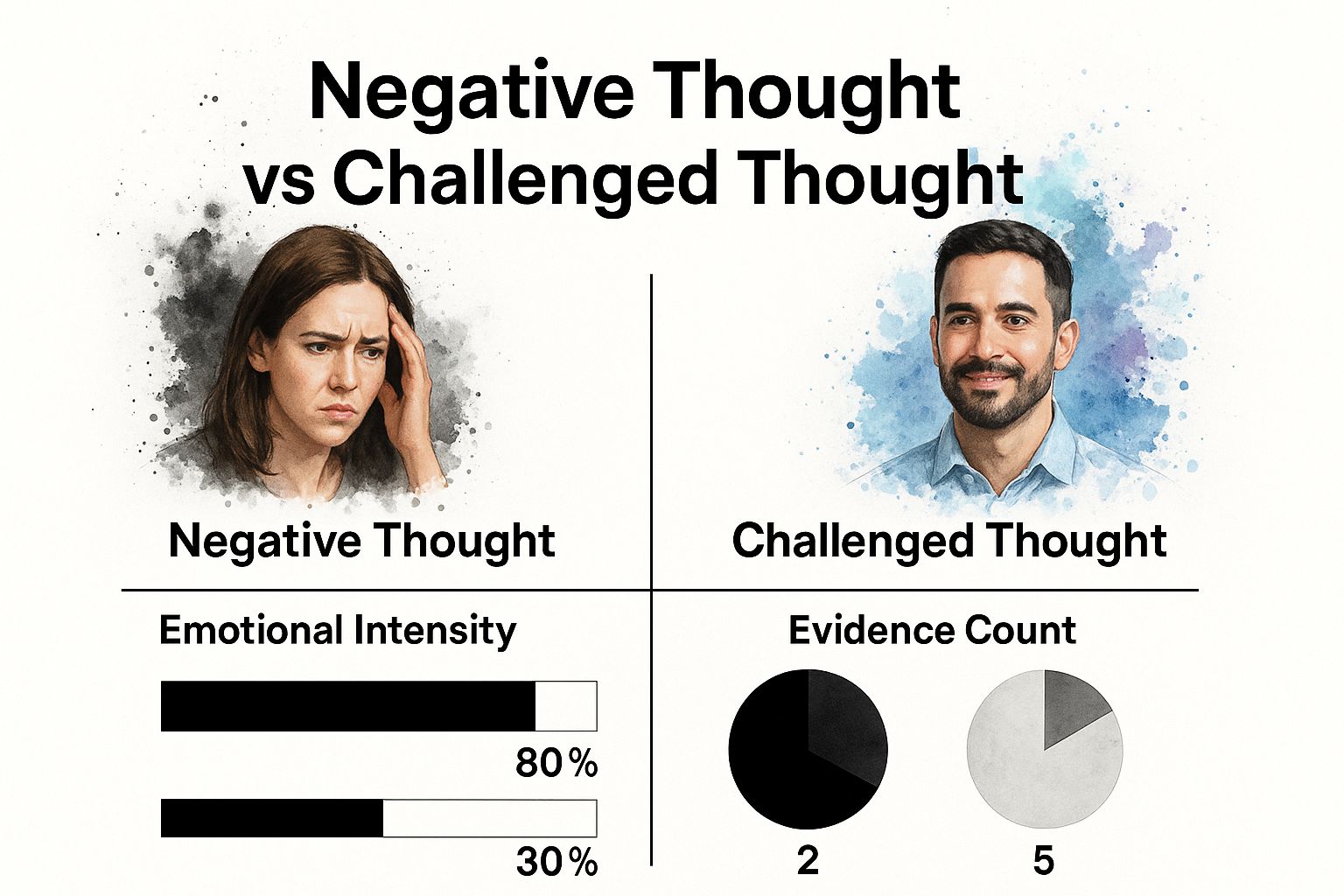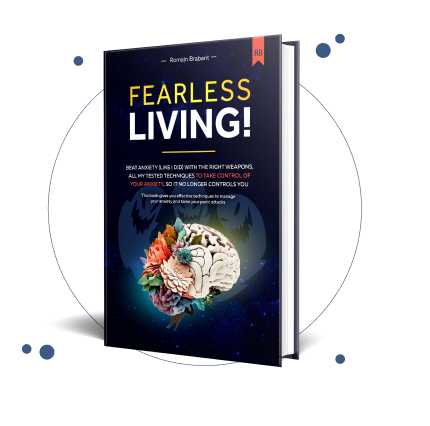
Feeling trapped by a storm of anxious thoughts can be incredibly isolating, but know this right from the start: you have the power to heal and find lasting calm.
The journey to overcoming negative thoughts isn't about trying to erase them completely—that’s an impossible goal. Instead, it's about learning how to see them, question their power, and step by step, build a life where they no longer control you. A life with less panic and more peace is not just a dream; it's an achievable reality.
Your Path to a Calmer Mind Starts Now

If you're here, you know the heavy weight of anxiety and the relentless loop of negative self-talk. It’s a struggle that can make you feel broken or fundamentally flawed, but I want you to hold onto this truth: this is not a personal failing. What you're experiencing is a set of learned mental habits. And just like any habit, with the right tools and practice, you can absolutely unlearn it and heal.
That feeling of being stuck? It’s not a permanent state. It's a sign that your old mental strategies aren't serving you anymore, and it's your cue to start building new, healthier ones. This guide is built on the real-world experiences of countless people who have walked this path, moving from a life dictated by fear to one filled with hope and possibility.
You Are Not Alone in This Fight
It's easy to believe you're the only one wrestling with these kinds of thoughts, but the reality couldn't be more different. Mental health challenges, especially those tangled up with anxiety and stress, are more common than ever.
In fact, a recent global study found that anxiety rates have climbed to 23%. This isn't just a statistic; it's a reflection of a widespread issue. It shows just how many people are looking for a way forward, just like you. You can learn more about this in the AXA Mind Health Report.
This isn't meant to be discouraging. It's meant to be validating. Your struggle is real, it's shared, and most importantly, it's something you can overcome.
The most powerful realization on the path to healing is that your thoughts are not commands. They are merely suggestions—and you don't have to accept every suggestion your mind makes.
Building the Foundation for Hope
The core of overcoming negative thinking lies in a simple but profound shift in perspective. Instead of being swept away by the current of anxiety, you learn to become an observer. You learn to step back and say, "I am having the thought that something bad will happen," rather than believing, "Something bad is going to happen."
See the difference? That small change in language creates crucial space between you and the thought. In that space, you find your power. It’s where you can start to question, challenge, and heal. This guide is dedicated to giving you the practical, proven techniques to do just that.
To get started, it helps to understand the foundational concepts we'll build upon. The table below breaks down the core ideas for your first steps toward a life free from the grip of negative thinking.
Your First Steps Away from Negative Thinking
| Concept | What It Means for You | First Action Step |
|---|---|---|
| Awareness | The ability to notice your thoughts without immediately buying into them. This is the first step to freedom. | Simply start labeling your thoughts. When a worry pops up, say to yourself, "That's a negative thought," without judgment. |
| Challenge | Questioning the validity of your negative thoughts and realizing they are not facts. | Ask one simple question when a negative thought appears: "Is this thought 100% true, with no exceptions?" |
| Action | Applying new skills to build mental resilience and create lasting change. | Pick one small, manageable action from this guide and practice it for just five minutes today. Consistency is your key to healing. |
Feeling overwhelmed by anxiety is exhausting, but you've already taken a courageous first step just by being here. You have found a resource dedicated to genuine recovery, and your journey toward a panic-free life begins right now.
How to Spot Your Unique Thought Patterns

Before you can change the anxious thoughts that cloud your mind, you first have to get to know them. This isn't about judging yourself. Think of it as becoming a detective of your own mind—curious, gentle, and just observing what's there.
The goal is to catch those Automatic Negative Thoughts (ANTs) that scurry through your brain. These are mental shortcuts that, while maybe intended to protect us, usually end up fueling the very anxiety we're trying to escape.
But here’s the hopeful part: Once you can see these patterns, you can start to take them apart. This awareness is the first real step toward dismantling negative thoughts and finding your peace. It's a sign that healing is already underway.
Learning the Language of Your Anxiety
Negative thoughts rarely come out of nowhere; they tend to follow predictable scripts called cognitive distortions. These are faulty, illogical thinking habits that warp our perception of reality, making everyday situations feel far more threatening than they actually are.
Learning to spot these distortions is like learning the language of your own anxiety. Let's look at a few of the most common culprits:
- Catastrophizing: This is the classic "what if" spiral. A tiny worry, like an unreturned text, snowballs into a full-blown catastrophe in your head. You might jump straight to, "They're definitely mad at me, and our friendship is over."
- Black-and-White Thinking: Also known as all-or-nothing thinking, this distortion leaves no room for nuance. If you aren't a runaway success, you must be a total failure. One small mistake at work translates to, "I'm terrible at my job and I'm going to get fired."
- Personalization: This is the habit of taking everything personally or blaming yourself for things that are completely out of your control. When a team project doesn't go well, your first thought is, "This is all my fault," even when multiple people and factors were involved.
Figuring out which of these patterns you default to is a huge leap toward gaining control. It helps you realize it's not you that's the problem—it's a faulty thinking habit that can be changed. You can learn more about these and other unhelpful thinking styles by exploring the full list of cognitive distortions.
The moment you can put a name to a thought—"Ah, that's catastrophizing again"—you create space between you and the thought. It loses its power and becomes just an observation. This is where you get your power back and begin to heal.
Become a Thought Detective with a Journal
One of the most powerful ways to identify your thought patterns is by keeping a journal. This is about short, focused entries that capture your thoughts as they happen. This simple practice makes your invisible mental habits visible and proves they can be changed.
A thought record helps you connect the dots between situations, the feelings they trigger, and the automatic thoughts that follow. Over time, you'll see exactly when and why your anxiety tends to spike, empowering you to intervene.
A Simple Thought-Journaling Method
When you feel a wave of anxiety, grab a notebook or open a notes app and quickly jot down the following. The key is to be brief and objective.
- The Situation: What was going on right before the negative thought hit? (e.g., "Got a last-minute meeting invite from my boss.")
- The Feeling: What emotion did you feel, and how intense was it from 1-10? (e.g., "Anxiety, 8/10.")
- The Automatic Thought: What was the exact thought that popped into your head? (e.g., "I must have done something wrong. I'm in trouble.")
- The Distortion: Can you name the thinking error? (e.g., "Catastrophizing and personalization.")
Doing this consistently, even just once a day, builds an incredible muscle of self-awareness. It proves to you that your thoughts are not facts. They are often just old, unhelpful habits running on autopilot.
And that realization is profoundly freeing. It means that if these are just patterns, they can be changed. You aren't destined to live in a state of panic forever. You are actively learning how to rewrite the script.
Actionable Techniques to Reframe Anxious Thoughts
Once you’ve started spotting your unique thought patterns, the next move is to actively challenge and reshape them. This is where you truly begin taking your power back. It's not about forcing "positive thinking," but about becoming a skilled mental lawyer, carefully examining the evidence to find a more balanced, hopeful perspective.
This process builds a tangible sense of control. Over time, these techniques become second nature, giving you a clear path toward a calmer mind. You're not just wishing for less anxiety; you're building the skills to create it.
This image shows just how dramatically challenging a thought can reduce its power.

As you can see, simply examining the evidence can slash the emotional intensity of a negative thought and help you build a much stronger, more realistic, and more hopeful perspective.
Put Your Anxious Thoughts on Trial
One of the most powerful ways to dismantle a negative thought is to treat it like a prosecutor's claim in a courtroom. Your anxious thought is the accusation, and you are the defense attorney, ready to examine the facts.
When an anxious thought pops up, don’t just accept it. Cross-examine it.
- Ask for the evidence. What facts truly support this thought? Be specific. "Feeling" like something is true doesn't count as hard evidence.
- Look for counter-evidence. What facts contradict this thought? Think about past experiences where the worst-case scenario didn't happen. Consider the strengths and resources you have that the thought is ignoring.
- Consider the source. Is this thought coming from a place of logic, or is it an old, habitual fear talking?
Let's say you get a short email from your boss that just says, "Can we talk tomorrow morning?" The automatic thought might be, "I'm getting fired." Time to put it on trial.
- Evidence For: "My boss sounded serious." (This is an assumption, not a fact).
- Evidence Against: "My performance review last month was positive. I completed all my major projects on time this quarter. My boss might just need to discuss the new project timeline."
By laying out the facts like this, the initial panic starts to fade, replaced by a much more reasonable and hopeful outlook.
Reframe Your Thinking with the Double-Standard Technique
We are almost always our own harshest critics. We hold ourselves to impossible standards that we would never dream of imposing on a friend. The double-standard technique uses this natural compassion to reframe your own negative self-talk.
The next time you're caught in a spiral of self-criticism, just pause and ask yourself this:
"What would I say to a dear friend who was in this exact situation and thinking these same thoughts?"
You’d probably respond with kindness, perspective, and encouragement. You wouldn't tell them they're a total failure. You’d remind them of their strengths and help them see the bigger picture.
Now, try turning that same compassionate advice inward. This simple shift can instantly soften the sharp edges of self-judgment and open the door to self-healing.
Learn to Shift Your Perspective
Anxious minds tend to get stuck on one terrifying explanation for an event, ignoring all other possibilities. A great way to break this habit is to actively brainstorm alternative—and often more likely—explanations.
If a friend cancels plans at the last minute, your automatic thought might be, "They don't want to see me anymore."
Instead, challenge yourself to come up with at least three other possibilities:
- They might have had a long, exhausting day at work and just need to rest.
- A family issue could have come up unexpectedly.
- They might be feeling unwell and didn't want to get you sick.
Suddenly, the initial, personal rejection feels much less certain and far less painful. When you feel overwhelmed, simple physical actions can also pull you back to the present. For more on this, check out our helpful list of grounding techniques for anxiety.
Remember, you aren't alone in this. Globally, mental health disorders affect nearly 970 million people, with anxiety and depression being the most widespread. This isn't just a personal goal; it's a vital skill for living a full life.
These reframing techniques aren't a one-time fix but a practice. Like building a muscle, they get stronger every time you use them. Each time you challenge a thought, you weaken its automatic power and build a new, more hopeful mental pathway. This is the practical work that leads to a life with less panic and more peace.
Building a Lifestyle That Quiets Anxiety

Learning to reframe thoughts is a huge step, but building a truly panic-free life requires more than just mental techniques. The path to lasting calm is paved with daily habits that actively support a peaceful mind and body.
This isn't about an overwhelming lifestyle overhaul. Lasting change comes from weaving small, sustainable habits into your routine—actions that create an environment where anxiety struggles to take root. When you build this foundation of well-being, you're giving yourself a powerful buffer against negative thinking and creating a strong base for healing.
The Mind-Body Connection in Action
It’s tempting to think of anxiety as “all in your head,” but your body is always listening. When you’re caught in a stress cycle, your body floods with hormones like cortisol, keeping you in a state of high alert. Building a lifestyle that quiets anxiety is about sending your body new signals—signals of safety, calm, and hope.
This is where simple, physical practices become your secret weapon. They are direct interventions that help regulate your nervous system.
- Gentle Movement: A short walk, light stretching, or yoga can burn off restless adrenaline and boost endorphins, your body's natural mood lifters, showing you that relief is within reach.
- Mindful Breathing: When panic rises, your breath becomes shallow and quick. By deliberately taking slow, deep belly breaths, you send a direct message to your brain that you're safe. This activates your body's "rest and digest" mode.
- Grounding Exercises: Simple sensory tricks can pull you out of an anxious spiral and plant you firmly in the present. Try holding an ice cube, smelling a strong essential oil, or just naming five things you can see. It sounds basic, but it's a powerful way to reclaim your calm.
Here's the magic of it: A 10-minute walk can clear your head just enough to challenge one negative thought. That small win lowers your stress, which helps you sleep better. Every positive action creates a hopeful ripple effect.
Fueling a Calmer Brain
What you eat has a direct impact on your mood. A diet packed with processed foods, sugar, and caffeine can feel like throwing gasoline on the fire of anxiety. On the flip side, a balanced, whole-foods diet gives your brain the raw materials it needs to be more resilient and calm.
Sleep is just as critical. It’s non-negotiable for mental health. While you sleep, your brain works hard to process emotions. Skimp on quality sleep, and you're far more vulnerable to negative thoughts. For a deeper dive, check out our guide on how lifestyle and diet changes can support anxiety management.
Finally, deliberately weaving calming activities into your routine is a game-changer for long-term peace. This could be anything—listening to music, gardening, or losing yourself in a creative project like the unexpected power of crochet for mental wellness.
You Are Not an Exception
If you're thinking, "This all sounds great, but my anxiety is different," it's vital to understand just how common these struggles are. Recent large-scale research found that 50% of the population will develop at least one mental health disorder by age 75.
This isn't a grim statistic. It's a message of solidarity and hope. It drives home the reality that facing down persistent negative thoughts is a near-universal human experience, not a personal failing. It also highlights why building a supportive, preventative lifestyle is an essential act of self-care that can lead to profound healing.
By making these small, consistent choices, you're doing more than just fighting off negative thoughts. You're building a fortress of well-being, one that will help you live a more hopeful, grounded, and panic-free life.
Your Hopeful Future With Less Panic
Let’s be real for a moment. This journey of overcoming negative thoughts isn't about flipping a switch and becoming "perfectly" calm overnight. It’s about progress. It’s about building a toolkit, one strategy at a time, so you can move forward with a genuine sense of hope and confidence in your ability to heal.
The most important thing to carry with you is this: healing from anxiety isn’t some far-off, impossible dream. It’s an achievable reality. Just by being here, you’ve already started walking the path toward a quieter, more fulfilling, and panic-free life.
Embracing the Messiness of Progress
It's easy to feel like you've failed when a bad day hits. A spike of anxiety can feel like a massive step backward. But this is exactly when you need to remember that setbacks are a normal part of healing, not a sign of failure.
I like to think of the mind as a room. Even if you aren't actively inviting negativity in, some dust and cobwebs are bound to show up. It’s just how things work.
"Even if you don’t think negatively… still some negativity will accumulate in your head… So just like we clean our body everyday, it would be nice if we can clean our head also on a daily basis."
This perspective shifts everything. Mental wellness isn't a final destination. It's a continuous, gentle practice of maintenance. Every time you question a thought or use a healthy coping skill, you're practicing. You're building your resilience and moving toward a more peaceful state of being.
You Are in the Driver’s Seat
The ultimate goal here is to build a life where anxiety no longer calls the shots. The tools you've gathered are all designed to put you back in control of your own mind, giving you the power to live freely.
Imagine a future where:
- An anxious thought pops up, but you can look at it with curiosity instead of being consumed by fear.
- You feel panic starting to rise, but you have go-to grounding techniques that bring you back to safety.
- You start making decisions based on your hopes and dreams, not what your anxiety will "let" you do.
This isn't a fantasy. It's the direct result of putting these strategies into practice, day by day. Every small act of challenging a negative thought strengthens your mental muscles, creating a life defined by your choices, not your fears. This path of healing leads directly to a panic-free life.
This path isn’t always a straight line, but you’re not starting from square one. For more structured guidance, you can explore the complete anxiety recovery steps in our detailed guide.
Remember, this journey is yours, but you don't have to walk it alone. Reading this far shows an incredible commitment to yourself. Hold onto that hope. You are actively building a future where you are in control—a future with less panic and a whole lot more peace.
Got Questions? We've Got Answers
Taking on negative thoughts is a deeply personal journey, so it's only natural to have questions. Think of this as a quick chat to clear up common roadblocks and give you an extra boost of confidence and hope.
Knowing what to expect can make the whole process feel a lot less intimidating. You already have the tools—now let's make sure you feel ready to use them to build your panic-free life.
What if These Techniques Don't Seem to Work at First?
This is a crucial question. It’s so important to remember that these techniques are skills, not magic tricks. Think about it: if you were learning to play the guitar, you wouldn't expect to nail a solo on day one.
Your brain has been running on old, automatic thought patterns for a long time. It needs time and consistent practice to carve out new, healthier, more hopeful pathways.
So, be patient and kind to yourself. Consistency is everything. If a technique feels awkward at first, don't give up. Try practicing for just five minutes a day. The goal isn’t instant perfection; it's gradual progress toward healing. Celebrate the small wins, like catching just one negative thought before it spirals. That's a victory.
How Do I Handle Recurring or Persistent Thoughts?
Some negative thoughts can feel incredibly sticky. When a thought won't go away, it's a signal to get curious, not frustrated. It's an opportunity for deeper healing.
Instead of fighting it head-on, try to understand what it might be trying to tell you. This is where journaling becomes a game-changer. You can dig into what journaling is and its many benefits to see how powerful it can be. A nagging thought is often a sign of an unmet need or an emotion that hasn't been fully processed.
A recurring thought isn't a sign of failure. It's an invitation to go a little deeper. By exploring its roots with compassion, you can often discover what you truly need to heal.
When Should I Consider Seeking Professional Support?
While these strategies are incredibly effective, sometimes the most hopeful step is asking for help. If you feel stuck, or if anxiety is seriously getting in the way of your life—your job, relationships, or health—it might be time to get extra support.
Think of a therapist as a personal trainer for your mind who can accelerate your healing. They can offer:
- Personalized Strategies: A pro can help you get to the root of your specific thought patterns and create a plan tailored just for you.
- Accountability: Knowing you have someone to check in with can provide the structure and motivation to keep you moving forward on your path to recovery.
- Advanced Tools: Therapists are trained in specialized methods like Cognitive Behavioral Therapy (CBT), one of the most effective approaches for rewiring negative thinking.
Reaching out for help is a sign of incredible strength and a powerful act of hope. It means you're committed to your healing and ready to use every resource available to build the panic-free life you deserve.
At The Anxiety Checklist, we believe everyone deserves to live a life free from the grip of anxiety. Our Fearless Living system is more than just an eBook; it's a complete, actionable toolkit designed by a 15-year anxiety survivor to put you back in control. With our 93-point interactive checklist and practical guides, you get a clear, step-by-step path to managing panic and reclaiming your peace. Start your journey to a calmer, more confident you today at https://anxietychecklist.com.

